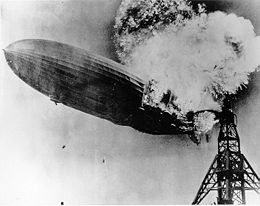The Hindenberg Was Sabotaged
June 26, 2010
 Editor's Note: Events like the sinking of the Titanic,
the destruction of the Hindenburg, 9-11 and the recent Oil Rig can best be viewed as psy-ops designed to
demoralize humanity and change commercial or political policy according
to Illuminati need.
Editor's Note: Events like the sinking of the Titanic,
the destruction of the Hindenburg, 9-11 and the recent Oil Rig can best be viewed as psy-ops designed to
demoralize humanity and change commercial or political policy according
to Illuminati need.by Watchdog
(for henrymakow.com)
There were 22 photographers present at 7 p.m. May 6, 1937 to film the Hindenburg's arrival (left.) This seems like overkill for an event which had already occurred 20 times in the previous year at the same field without incident. So why would this typical New Jersey airship landing require 22 separate photographers, five of whom were newsreel photographers?
The Hindenburg was behind schedule by exactly 12 hours. It was supposed to land at 7 am. Both the captain and first officer admitted they were wary of a possible bomb attempt because of tensions with Germany. Sabotage was a serious possibility in those days, yet it was not to be mentioned by the press after the "accident".
Everybody knows what supposedly happened. But not one of the photographers caught the actual "spark" that led to the "explosion". There was plenty of footage of a large fireball above the airship with a portion of the outer skin opened up. There was footage of the poor souls trying to get away from the burning wreckage. But no one caught the spark.
It was the most extraordinary "missed-the-shot" photographic blunder of all time.
HYDROGEN DOESN'T BURN
The biggest problem with the Hindenburg explosion scenario is that Hydrogen, by itself, separated from oxygen as in a sealed gas cell (Hindenburg had 16 separate cells) does not burn. Hydrogen and oxygen need to be combined stoichiometrically. You would take a sample of water, convert it into a gas thus composing two parts hydrogen to one part oxygen. This burns with about seven times the amount of energy than an equal weight of petroleum. But only pure hydrogen was in the Hindenburg.
Blatantly striking a match inside a hydrogen fuel cell would do nothing at all except immediately go out (as soon as the oxygen, in solid oxide form, contained within the match head powder was exhausted.) If a static spark ignited Hindenburg, it would have started burning on the outside of the ship's skin where air containing oxygen could have mixed with the hydrogen escaping from a small leak. Even if there was a static electricity spark, as had never occurred in 30 years of successful operation, how would a flame requiring oxygen burn it's way inside the gas cell where there is no oxygen?
The Hindenburg had instruments that would detect and transmit the slightest changes in gas pressure to the bridge, so any sizable leak would have caused a pressure drop almost immediately and would have been detected.
The pilots would have delayed getting close to any structures and sought to correct the problem. If a spark had then occurred in this split section time window, then we would have seen a small flame on the outside skin burning like the head of a small gas torch where the hole was. But no way could this flame have gone inside the cell, and no way were there any makings of a bomb or explosion there.
[This story sounds very similar to the story of TWA's doomed flight 800 in which it was reported by the media that the center fuel tank "exploded" while outbound from New York to Paris. Did you know that the TWA flight 800 examination commission paid millions of dollars to a government contractor to conduct a test that would show how the fuel exploded within a similar tank? Did you know that after trying every possible manner of detonating jet fuel "fumes," they never could get it to go off? So they left that little fact out of the report.]
SAFETY RECORD
Another very large problem with the story of the Hindenburg disaster: The seven year performance of the Graf Zeppelin. This amazing airship proceeded the Hindenburg. Amongst Graf Zeppelin's many incredible aviation feats was her non-stop flight around the world in 1929 carrying 20 passengers! Passenger service using piston driven aircraft did not even offer New York to Paris service until 1939.
Over seven years, Graf Zeppelin logged more than 1,000,000 miles, carried 18,000 passengers in safety and comfort, and made 144 successful Atlantic crossings. Graf Zeppelin used only hydrogen as the lifting material.
Airships are a simple form of anti-gravitation. They are much more efficient for transporting people and cargo than piston driven and modern day aircraft which have to lift such heavy fuel loads and plow through the air to keep them aloft. With a streamlined blimp all one does is cast off a line and let the airship rise. Upon reaching a height of about 500 feet, the engines are started and away they go, like a ship floating in water.
Airship use should have been expanded and continued, but that they were shutdown in favor of inefficient winged aircraft which today consume ungodly amounts of petroleum kerosene, otherwise known as high priced jet fuel.
Postscript
In 1948, Gestapo Chief Heinrich Muller told his CIA interrogator James Kronthal that the Hindenburg was sabotaged, but they never caught the instigator.
--
Also by Watchdog - Titanic & Hindenburg: Two Psy-ops-One Agenda?
More about hydrogen







David said (June 30, 2010):
The silver appearance of the Hindenburg was due to a surface varnish of powdered aluminum in a paint formula that resembles the chemistry of modern solid booster rocket fuel.
A small spark jumping from a wet rope would be all that was required to start the flame.
Regardless of much speculation, translation of a letter handwritten in German on June 28, 1937, by Hindenburg investigator and electrical engineer Otto Beyersdorff states "The actual cause of the fire was the extreme easy flammability of the covering material brought about by discharges of an electrostatic nature ..." Recently, NASA investigator Dr. Addison Bain has verified this finding by scientific experiments that duplicated the vigorous ignition by static discharge to the aluminum powder filled covering material. Spectacular colors of this type of combustion were produced from the burning skin of the giant airship. Dr. Bain concluded that the Hindenburg would have burned and crashed even if helium would have been used as the lifting gas. Dr. Bain noted that the particular type of aluminum powder particles, which are flake like in shape, are particularly sensitive to electrical discharge.
--
Thanks David
It's hard to believe they would use a coasting that is so flammable. After all, these ships were exposed to lightning all the time.
henry
FYI